|
Many people believe the desert is a barren, dry place with little life. Although deserts usually have a scorching sun and little rain, many animals both live and thrive within White Sands National Park. The reptiles of White Sands show us their strategies for survival in the most unique desert of all. 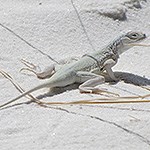
NPS Photo Bleached Earless Lizard Holbrookia maculata ruthveni At about four inches long, the bleached earless lizard isn’t really earless or bleached. Its name comes from the lighter variation of the common lesser earless lizard. The term “earless” comes from the fact that these lizards do not have external ear openings. Found throughout the dunefield, these lizards like to bury themselves just under the surface in loose, sandy soil. They are identifiable by two black spots on each side. They feast on a variety of insects and spiders. 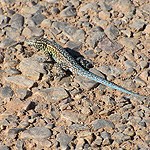
NPS Photo Common Side-blotched LizardUta stansburiana At about 5.5-inches long and found throughout the park, this is the only lizard at White Sands that is apt to be active on warm days year-round. It is identifiable by a single dark blotch just behind each foreleg. The males roam throughout an area of about 2,500-square yards and can be very territorial, especially during breeding season. This lizard is found in a wide-range all throughout the United States, but varies in coloration and pattern depending on its environment. 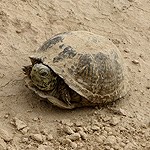
NPS Photo Desert Box TurtleTerrapene ornata luteola Feeding mainly on small insects and sometimes plant matter, the box turtle inhabits mainly the central portion of the United States in between the Rocky Mountains and the Mississippi River. Here at White Sands, the subspeciesTerrapene ornata luteola, or the desert box turtle, lives along the edges of the park's boundaries where Chihuahuan Desert shrub is still predominant. In contrast to the other subspecies, the ornate box turtle, the desert box turtle is more adequately adapted to arid habitats. 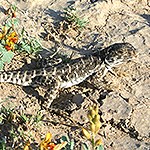
Doug Burkett, Senior Scientist, ECO-Inc. Photo Long-nosed Leopard LizardGambelia wislizenii Although we at White Sands are known for our white lizards, there are other lizards that make a home here too. The long-nosed leopard lizard is one of these. These lizards are fairly big, with a rounded body between 3.25 and 5.75 inches (8.3-14.6 cm) long and a tail that can be almost twice their body length! They’re called “long-nosed” to set them apart from their shorter-nosed relatives in California (the blunt-nosed leopard lizard). They have gray throats, and breeding females have red or orange markings along their sides. Of course, leopard lizards also have dark spots on their bodies, thus giving them their name. 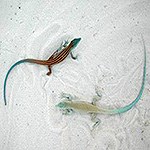
NPS Photo Little White WhiptailAspidoscelis gypsi Have you ever seen or experienced adaptation? The image to the left shows how “survival of the fittest” really works! There is some debate whether the little white whiptail (bottom lizard) is its own species or a subspecies of the little striped whiptail lizard (top lizard). Researchers love coming to White Sands to learn about and study the unique species that inhabit the gypsum dunes. The little white whiptail is prey to many birds and mammals. This lizard will detach itself from its tail as an escape strategy. MassasaugaSistrurus catenatus The desert massasauga is characterized by two white stripes on its face and brown dorsal patches outlined in white. It is usually paler than the eastern and western subspecies, and its rattle is higher-pitched when compared to that of other snakes. Although the massasauga can move using undulating waves like most snakes, it prefers to move on loose sand by using the “sidewinding” technique. Like most other creatures at White Sands, the massasauga prefers to come out during the cooler times of day. 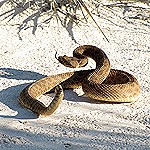
NPS Photo Prairie RattlesnakeCrotalus viridis Reaching lengths of up to four feet, the prairie rattlesnake is found mostly in desert scrub habitats. Hibernating in winter, prairie rattlers often return to the same den year after year. When awake during warm months, they establish hunting territories and eat mainly lizards and small mammals. This snake can be a variety of colors, such as tan, grey, or olive green. The oval blotches that run down the torso may be clear or indistinct. Due to poor eyesight, prairie rattlesnakes use their forked tongues and heat-sensitive pits to find food. 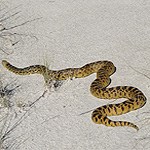
NPS Photo Sonoran Gopher SnakePituophis catenifer affinis This large, heavy-bodied snake averages about four feet in length but can grow up to seven feet. The underbelly of those in White Sands is often creamy as opposed to yellow, beige, or tan as it is in other areas. A constrictor, the Sonoran gopher snake is harmless to humans and eats small mammals, birds, bird eggs, and even lizards. However, the preferred prey of choice at White Sands is the pocket gopher. A diurnal creature, this snake is most active at dusk and dawn. It prefers to avoid the mid-day heat by hiding in rodent burrows. 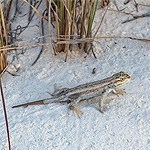
NPS Photo Southwestern Fence LizardSceloporus cowlesi Found throughout White Sands, the Southwestern fence lizard can be black to light brown to white, depending on where it’s found. Males are easy to identify since they have bright blue belly patches, as well as blue or green chin patches. Although diurnal, this lizard prefers to avoid the mid-day heat of summer and is most active mid-morning and late afternoon. Instead of actively hunting, it sits and waits for prey to wander by. Insects are its favorite meal, but it will eat spiders, snails, and other small lizards. 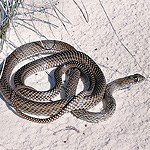
NPS Photo Western CoachwhipMasticophis flagellum Harmless to humans, the coachwhip is a long, slender, tan or brown snake that can reach up to seven feet in length. Most of the coachwhips at White Sands have a pink color on the belly that becomes more pronounced under the tail. This snake shows a nasty temper when capture is attempted. In captivity, while holding its own head still, the coachwhip will whip its tail back and forth around the edges of its cage to dislodge any lizards hiding there. When the lizard moves, it becomes a meal. It is believed the same technique is used in the wild. 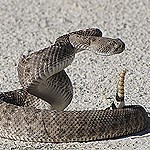
NPS Photo Western Diamondback RattlesnakeCrotalus atrox The western diamondback rattlesnake can range from two to six feet in length! Characterized by the diamond-shaped blotches that run along its torso, this wide-spread rattlesnake can range in color depending on its most common surroundings. The western diamondback rattlesnake preys on small mammals such as the Apache pocket mouse and prairie gopher. This swift snake quickly responds defensively to any threat by rattling and striking. This snake is identifiable by even-sized black and white bands around the end of the tail. |
Last updated: September 24, 2023
